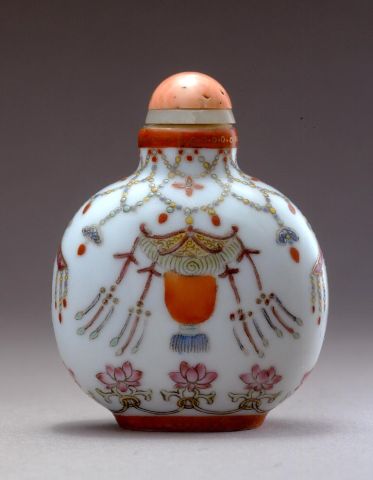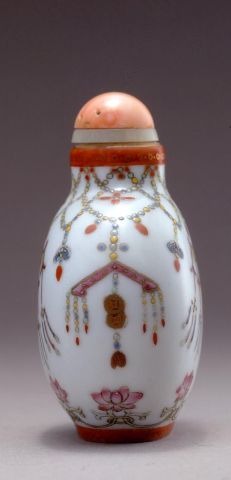

Bottle ID: 00451
PORCELAIN, ENAMELED FAMILLE ROSE, BUDDHIST ROSARY & FLOWERS
Date: 1821-1850
Height: 53 mm
Porcelain, hard paste, of rounded bulbous form, decorated in the famille rose palette with iron-red and gilding, on each side with a design of tasseled and shaded lanterns; the foot with a design of interlocking blossoming lotus flowers, the neck and shoulders replicating a Buddhist rosary with lingzhi fungus ends, the foot and mouth with an iron-red and gilded band; the foot with a four character iron-red Daoguang nianzhi mark in seal script and of the period.
Imperial, attributed to the Palace Workshops, Jingde Zhen.
Similar Examples:
Lawrence, Clare. Miniature Masterpieces from the Middle Kingdom - The Monimar Collection of Chinese Snuff Bottles, 1996, pp. 184-185, no. 86.158.
Moss, Hugh, Victor Graham and Ka Bo Tsang. The Art of the Chinese Snuff Bottle - The J & J Collection, 1993, Vol. I, pp. 331-332, no. 193.
Sotheby's, New York, March 22, 2000, lot 203, a Mid-West Collection.
Sotheby's, New York, March 27, 2003, lot 313, Collection of Ann & John Hamilton.
Provenance:
Clare Lawrence Ltd.
J. W. A. International
Exhibited:
Annual Convention ICSBS Toronto, October 2007
Though classically attributable to the Daoguang period in shape, bluish glaze and by its basemark, this bottle with its combination of famille rose and iron-red enameling and gilded is stylistically similar to porcelain bottles produced for the Court in the Qianlong period. The Qianlong Emperor was a devout Buddhist as were both Kangxi and Yongzheng, and many porcelain wares were decorated with Buddhist symbolism. That this practice would continue though the Jiaqing period and into the Daoguang period, even as the quality of wares went down, is no surprise. Though lacking any real innovation the Imperial Kilns remained capable of producing fine quality wares with traditional designs, though in far fewer numbers.
< Back to full list
 English
English 中文
中文